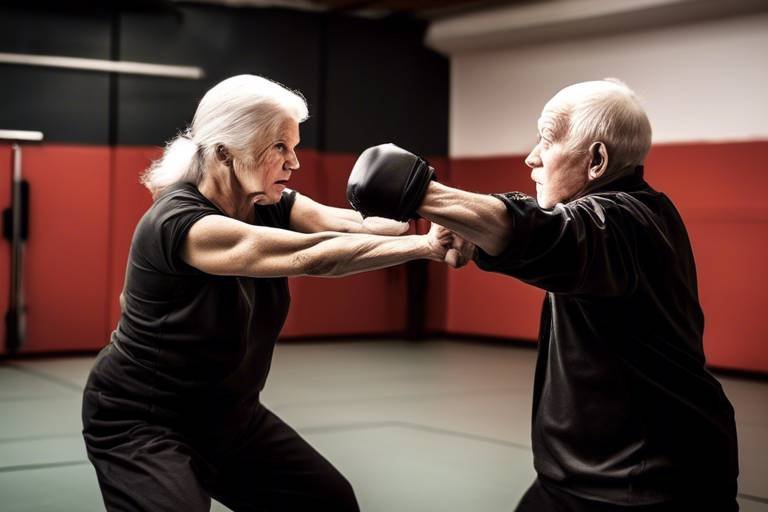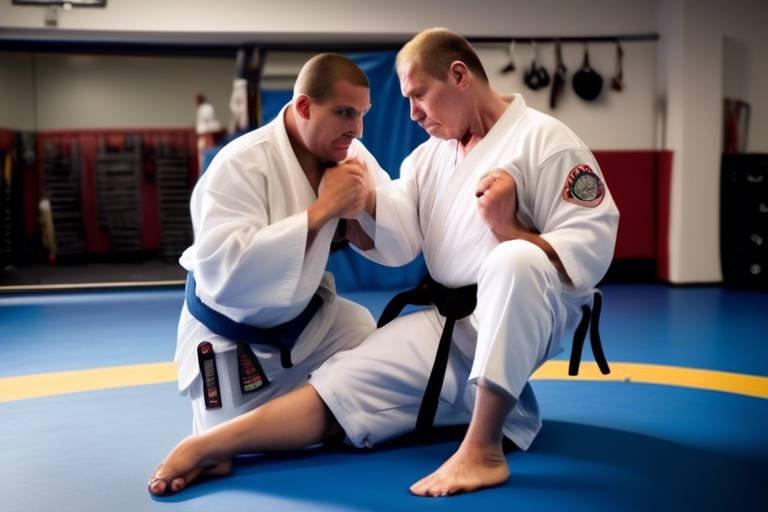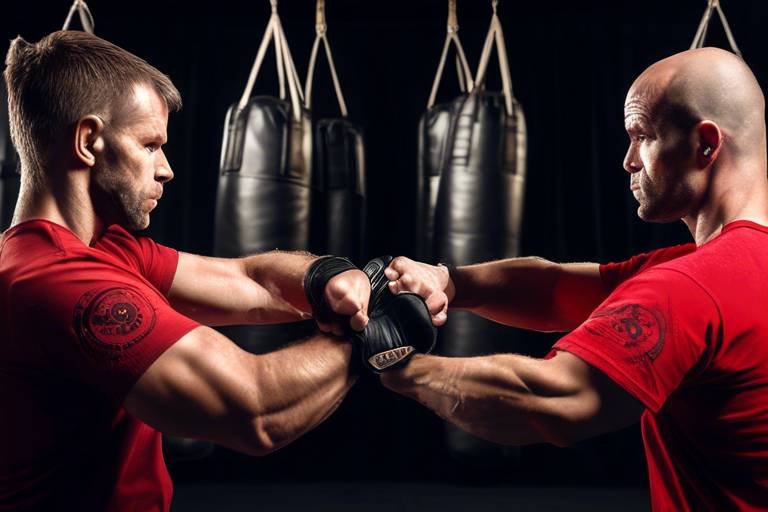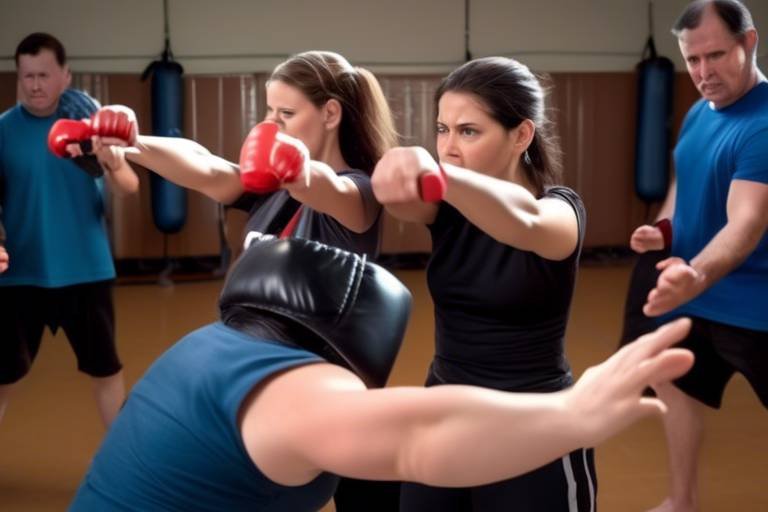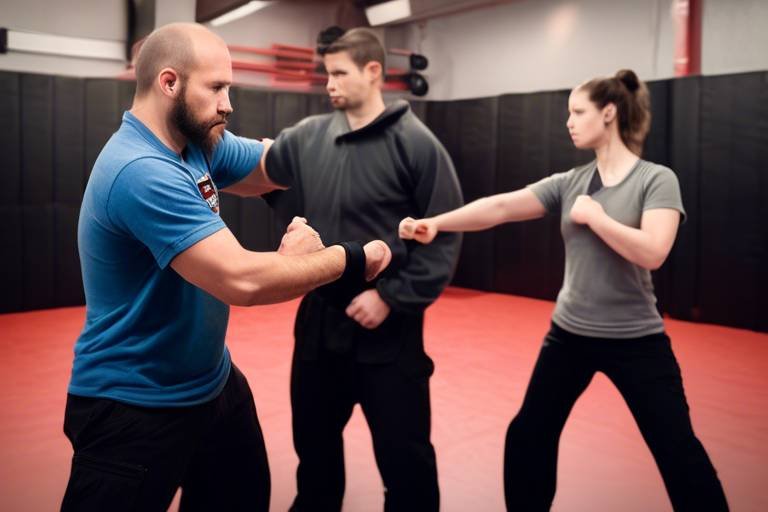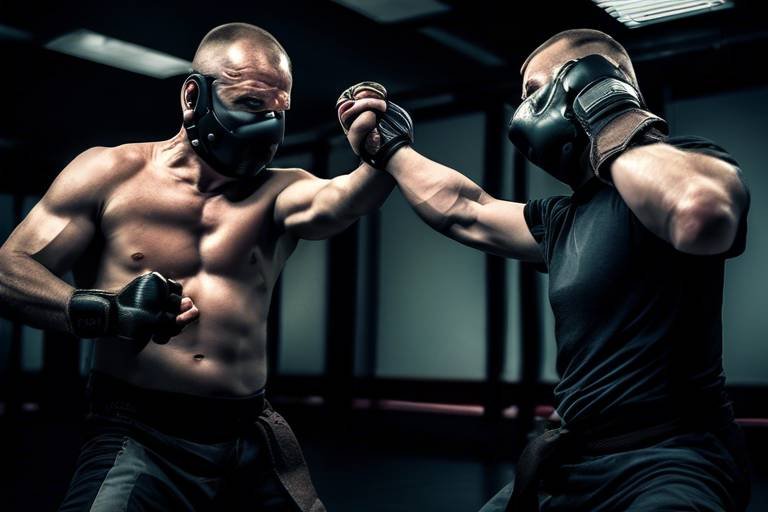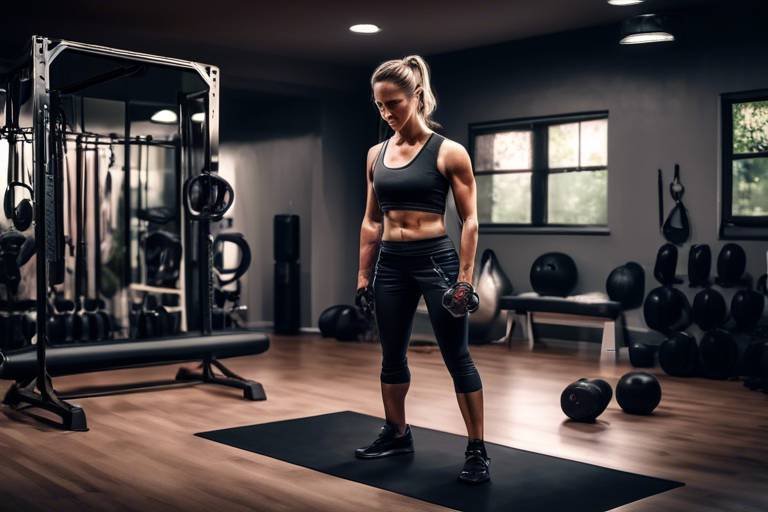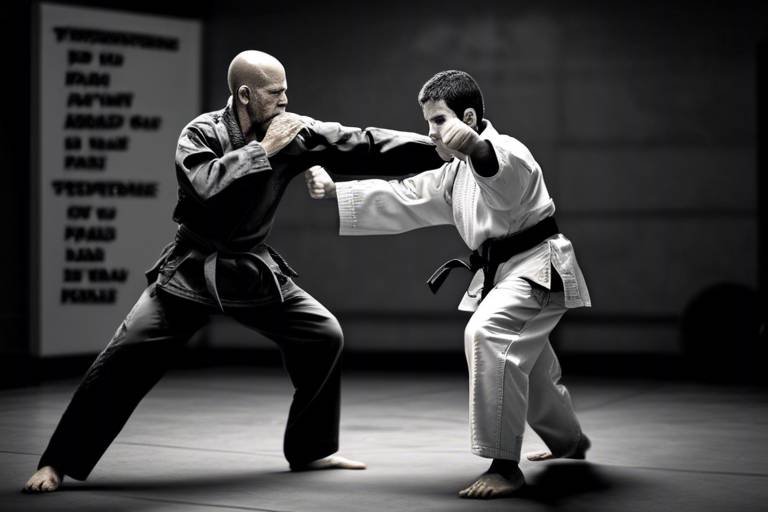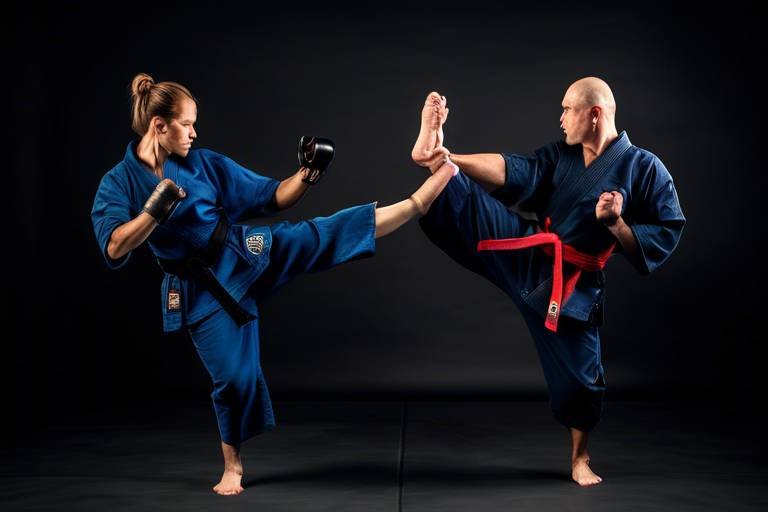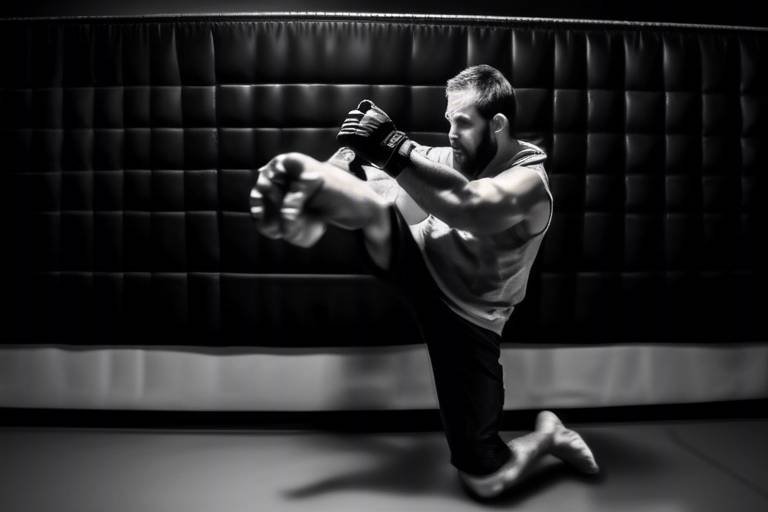Beginner-Friendly Self-Defense Techniques to Start Practicing Today
In today's world, understanding self-defense is more important than ever. Whether you're walking home late at night or simply want to feel more secure in your daily life, having the right techniques at your disposal can make all the difference. This article explores essential self-defense techniques that are easy for beginners to learn. You'll discover simple methods to enhance your safety and confidence in various situations, empowering you to take control of your personal security.
Before diving into specific techniques, it's crucial to grasp the fundamental principles of self-defense. One of the most important aspects is situational awareness. This means being conscious of your surroundings and recognizing potential threats before they escalate. By staying alert and aware, you can often avoid confrontation altogether. Remember, the best fight is the one you don’t have to engage in. Self-defense is not just about physical techniques; it's about making informed decisions in threatening situations. Think of it as being a chess player, always anticipating your opponent's next move.
Now that you have a grasp on the basics, let’s explore key stances and movements that form the backbone of effective self-defense. Mastering these techniques will help you maintain balance and readiness when faced with an aggressive opponent. Just like a tree that needs strong roots to withstand a storm, your stance provides the stability you need in a confrontation.
Defensive stances are your first line of protection in confrontational situations. Understanding how to position your body is crucial for maximizing your defensive capabilities. Let's take a closer look at two fundamental stances.
The neutral stance is a relaxed position that allows for quick movement. Imagine standing with your feet shoulder-width apart, knees slightly bent, and hands up near your chin. This stance prepares you for potential threats without appearing confrontational. It’s like a boxer waiting for the bell to ring—ready but not aggressive.
When the situation escalates, transitioning to a fighting stance is essential. This stance is more aggressive and ready for action. Your feet should be staggered, with one foot slightly in front of the other, and your hands up to protect your face. Think of it as a coiled spring, ready to unleash power when needed. This readiness can significantly enhance your ability to defend yourself effectively.
Once you've mastered your stances, it's time to learn basic strikes and blocks. These techniques are your tools for creating distance and protecting vital areas of your body. For instance, a well-placed punch or kick can create the opportunity you need to escape a dangerous situation. Remember, the goal is not to engage in a prolonged fight but to create an opening for your escape.
Understanding how to target vulnerable areas on an attacker can significantly increase your chances of successfully defending yourself. Strikes to specific spots can incapacitate an assailant momentarily, giving you the chance to escape. Here are some areas to focus on:
Striking the eyes or nose can incapacitate an attacker momentarily. Techniques such as a quick jab to the nose or a poke to the eyes can create an opportunity for you to escape. Think of it as a surprise attack—something unexpected that leaves your opponent momentarily stunned.
Targeting the throat or groin can be highly effective in self-defense. A swift strike to the throat can disrupt breathing, while a kick to the groin can cause extreme pain. These techniques should be executed with caution and precision, ensuring that you maximize your chances of success while minimizing risk to yourself.
Regular practice is vital for building muscle memory in self-defense techniques. The more you practice, the more instinctive your responses will become. Here are some tips for effective practice:
Engaging in solo drills helps reinforce techniques without a partner. You can practice your stances, strikes, and blocks in front of a mirror to refine your movements. Imagine yourself in various scenarios, visualizing how you would respond. This mental rehearsal can be just as powerful as physical practice.
Training with a partner allows for realistic practice scenarios. You can simulate attacks and practice your responses in a controlled environment. Safety is paramount, so always ensure that both you and your partner are on the same page regarding the intensity of the practice. Think of it as a dance—both partners need to be in sync to create a seamless performance.
Self-defense training not only equips you with skills but also builds confidence. As you master these techniques, you'll notice a positive impact on your self-esteem and outlook on personal safety. The knowledge that you can defend yourself can transform how you navigate the world. It’s like carrying an invisible shield—no one can see it, but you know it’s there, providing you with a sense of security.
- How long does it take to learn self-defense? - The time it takes to learn self-defense varies by individual, but consistent practice over weeks or months can lead to significant improvement.
- Is self-defense training suitable for everyone? - Yes! Self-defense training is beneficial for individuals of all ages and fitness levels.
- What should I wear for self-defense training? - Comfortable clothing and supportive footwear are recommended to allow for ease of movement.
- Can I practice self-defense techniques at home? - Absolutely! Many techniques can be practiced alone or with a partner in a safe environment.

Understanding Self-Defense Basics
When it comes to self-defense, understanding the basics is like having a sturdy foundation for a house. Without it, everything else can crumble. The first step in this journey is situational awareness. This means being aware of your surroundings, recognizing potential threats, and understanding how to react in various situations. Think of it as having a sixth sense that helps you stay alert. For example, when walking down a street, notice the people around you, the layout of the area, and any potential exits in case of an emergency. This awareness can often prevent confrontations before they even start.
Another important principle is the idea of avoiding confrontation whenever possible. It’s not about running away from danger but rather about choosing your battles wisely. Sometimes, the best defense is to de-escalate a situation or walk away. Imagine being in a heated argument; recognizing when it's time to step back can save you from unnecessary trouble. Remember, self-defense isn’t just about physical techniques; it’s also about using your brain. The goal is to stay safe, not to prove how tough you are!
Now, let’s delve deeper into what self-defense entails. It’s essential to understand that self-defense is not just about reacting; it’s about being proactive. This means taking steps to minimize risks before they escalate into dangerous situations. For instance, if you find yourself in a crowded area, try to keep your belongings secure and stay close to well-lit spaces. These small actions can significantly increase your safety.
Moreover, being aware of the legal aspects of self-defense is crucial. Many people don’t realize that self-defense laws vary by location. In some places, you can only use physical force if you are directly threatened, while others may allow for a broader interpretation. Understanding these laws can help you make informed decisions. For example, if you’re in a situation where you feel threatened, knowing how much force you can legally use can prevent you from facing legal consequences later.
In summary, mastering the basics of self-defense involves a combination of awareness, avoidance, and understanding the legal framework surrounding self-defense. By honing these skills, you empower yourself to make informed decisions that can protect you in threatening situations. So, stay alert, trust your instincts, and remember that the best defense is often a good offense when it comes to your safety!
- What is situational awareness? Situational awareness is the ability to perceive and understand your surroundings, helping you identify potential threats before they escalate.
- Is it better to avoid confrontation? Yes, avoiding confrontation is often the safest option. It’s important to choose your battles wisely and de-escalate situations when possible.
- Do self-defense laws vary by location? Yes, self-defense laws differ by region, so it’s essential to understand the laws in your area to ensure you act within legal boundaries.

Essential Stances and Movements
When it comes to self-defense, the way you position your body can make all the difference. Think of stances and movements as the foundation of a house; without a strong base, everything else can crumble. By mastering these essential techniques, you'll not only enhance your ability to protect yourself but also bolster your confidence in any situation. So, let’s dive into the key stances and movements that every beginner should know!
Defensive stances are your first line of defense in any confrontation. They allow you to react quickly while maintaining balance and control. Imagine standing firm like a tree, deeply rooted and ready to sway with the wind rather than topple over. Here are two fundamental stances to get you started:
The neutral stance is all about being relaxed yet prepared. Picture yourself at a social gathering where you're not looking for trouble but are aware of your surroundings. Your feet should be shoulder-width apart, with your knees slightly bent. This position allows for quick movement in any direction. Keeping your hands up near your chin can help you protect your face without appearing overly aggressive. It's like being a coiled spring, ready to unleash energy when needed!
When the situation escalates, transitioning to a fighting stance is crucial. This stance is more aggressive and shows your readiness to defend yourself. To adopt this position, step one foot back, keeping your weight balanced on the balls of your feet. Your hands should be up, elbows tucked in, and your fists clenched. Think of it as gearing up for a race; you're poised to sprint into action. This stance not only prepares you for an attack but also signals to an aggressor that you mean business!
Now that you've got your stances down, let's talk about the basic strikes and blocks that will help you defend yourself effectively. These techniques are essential for creating distance between you and an attacker while protecting vital areas of your body. Remember, the goal is to escape rather than engage, but knowing how to strike can give you the upper hand if needed.
Practicing these movements will help you build muscle memory, making your responses instinctive. As you train, visualize the scenarios where you might need to use these techniques, and let that fuel your practice sessions!

Defensive Stances
When it comes to self-defense, adopting the right defensive stance can make all the difference. Think of it as the foundation of a house; without a solid base, everything else can crumble. A defensive stance not only prepares you for potential threats but also helps you maintain balance and control. It’s crucial to position your body in a way that maximizes your defensive capabilities while minimizing vulnerability.
There are a couple of stances that every beginner should familiarize themselves with. The first is the neutral stance, which is relaxed yet alert. Imagine standing in a way that allows you to quickly pivot or move in any direction without looking aggressive. This stance is perfect for situations where you want to be prepared but not provoke an altercation. Your feet should be shoulder-width apart, and your knees slightly bent, giving you a solid grounding while keeping your body loose.
On the other hand, the fighting stance is more aggressive and ready for action. This is where you shift gears from being passive to being prepared to defend yourself. In this position, your dominant foot should be slightly back, allowing you to push off quickly if needed. Your hands should be up, protecting your face, while your elbows stay close to your body to guard against strikes. It’s like being a coiled spring, ready to unleash your energy at a moment’s notice.
Here’s a quick comparison of the two stances:
| Stance | Description |
|---|---|
| Neutral Stance | Relaxed position, ready to move without appearing confrontational. |
| Fighting Stance | More aggressive posture, prepared for action and defense. |
Mastering these stances is essential because they set the groundwork for all your defensive maneuvers. Remember, the goal is to be ready for anything while maintaining composure. Practice switching between these stances until they become second nature. The more comfortable you are with your body positioning, the better equipped you’ll be to handle unexpected situations. So, next time you find yourself in a potentially dangerous scenario, your body will instinctively know how to respond.

Neutral Stance
The is often overlooked, yet it is one of the most crucial positions in self-defense. Imagine standing in a relaxed yet ready position, like a coiled spring, poised to react at a moment's notice. This stance is not about aggression; instead, it’s about preparedness. By adopting a neutral stance, you can project calmness while also being alert to your surroundings. It’s a balance between appearing non-threatening and being ready to defend yourself if necessary.
To achieve the neutral stance, start by positioning your feet shoulder-width apart. This base provides stability and balance, allowing you to move swiftly in any direction. Your knees should be slightly bent, which not only aids in balance but also prepares your body to spring into action. Keep your hands up, but not in a fighting pose; think of them as shields protecting your vital areas. This way, you can easily transition into defensive maneuvers if the situation escalates.
Here’s a quick breakdown of how to maintain an effective neutral stance:
- Feet Position: Stand with your feet shoulder-width apart for balance.
- Knees: Keep them slightly bent to enhance mobility.
- Hands: Raise them to about chest level, palms facing inward, ready to protect.
- Body Posture: Keep your back straight and shoulders relaxed to avoid looking aggressive.
Practicing this stance regularly can greatly enhance your situational awareness. When you're in a neutral stance, you can easily observe your surroundings and react to potential threats without drawing attention to yourself. Think of it like being a chameleon, blending into your environment while remaining alert. The beauty of the neutral stance lies in its versatility; you can quickly shift into a more aggressive posture if needed, but it allows you to assess the situation first. This is especially important in self-defense, where avoiding confrontation is often the best strategy.
In summary, mastering the neutral stance is a vital step in your self-defense journey. It not only prepares you for potential threats but also helps you maintain a sense of calm and control. So, the next time you're out and about, take a moment to practice your neutral stance. It could make all the difference in a critical situation.

Fighting Stance
The is your go-to position when you need to be ready to defend yourself. Think of it as the difference between standing casually at a party and being ready to sprint at a moment's notice. When you adopt a fighting stance, you shift your body into a more defensive and aggressive posture, allowing you to react quickly to any threats. This stance not only prepares you for action but also helps you maintain balance and control over your movements.
To get into a fighting stance, start by positioning your feet shoulder-width apart. Your dominant foot should be slightly behind your non-dominant foot, creating a solid base. This way, you can pivot easily, whether you need to strike or evade. Your knees should be slightly bent, which keeps your center of gravity low and ready for any sudden movements. Keep your hands up, protecting your face, with your elbows tucked in to shield your body. This position not only guards vital areas but also prepares you to throw punches or block incoming attacks.
Here’s a quick breakdown of the key elements of a fighting stance:
| Element | Description |
|---|---|
| Foot Position | Feet shoulder-width apart, dominant foot back. |
| Knee Bend | Keep knees slightly bent for balance. |
| Hand Position | Hands up to protect the face, elbows in. |
Practice transitioning into this stance from a neutral position. It’s all about muscle memory. The more you practice, the more instinctual it becomes. Imagine your body as a coiled spring—ready to unleash energy and power when needed. And remember, confidence in your stance can often deter potential attackers. They can sense if you’re ready to defend yourself, which might make them think twice.
When you find yourself in a situation where you need to use your fighting stance, stay calm. Take a deep breath and focus on your posture. Visualize your movements—how you’ll strike, block, or evade. This mental preparation can make all the difference. Your fighting stance is not just about physical readiness; it’s also about the mental edge it gives you. So, stand tall, be aware, and let your fighting stance empower you!

Basic Strikes and Blocks
When it comes to self-defense, understanding is essential. These techniques not only help you defend yourself but also empower you to take control of a potentially dangerous situation. Imagine a scenario where you’re confronted by an aggressor; having the knowledge of how to strike effectively can make all the difference. Strikes can create distance, while blocks protect you from incoming attacks. Let’s dive into some fundamental techniques that every beginner should know.
First, let’s talk about strikes. Striking is about delivering a quick and effective blow to deter an attacker. Here are a few basic strikes that are easy to learn:
- Punches: A straightforward technique, punches can be delivered with your dominant hand. Aim for the face or body of the attacker to create an opening for escape.
- Elbow Strikes: Elbows are powerful and can be used at close range. They are particularly effective if an attacker is too close for a punch.
- Knees: Knee strikes are excellent for targeting the groin area, which can incapacitate an attacker quickly.
Now, let’s shift our focus to blocks. Blocking is about preventing an attack from reaching you. Here are some fundamental blocking techniques:
- High Block: This technique is used to defend against strikes aimed at your head or upper body. Raise your arms to deflect the attack.
- Low Block: This is effective against low strikes aimed at your legs or midsection. Lower your arms to intercept the attack.
- Inside Block: This technique is useful for defending against punches coming from the side. Use your forearm to redirect the attack away from your body.
Practicing these strikes and blocks regularly is crucial for building muscle memory. Think of it like learning to ride a bike; the more you practice, the more natural it becomes. You might want to consider setting aside time each week to practice these techniques, either alone or with a partner. Remember, the goal is to react instinctively when faced with a threat.
Incorporating these basic strikes and blocks into your self-defense training will not only enhance your skills but also boost your confidence. Knowing you have the ability to defend yourself can be incredibly empowering. So, why not start today? Grab a friend or find a safe space to practice these techniques. You’ll be surprised at how quickly you can learn and adapt!
Q: How long does it take to learn basic self-defense techniques?
A: The time it takes to learn varies from person to person, but with consistent practice, you can grasp the basics within a few weeks.
Q: Do I need a partner to practice self-defense?
A: While practicing with a partner can be beneficial, many techniques can be practiced solo. Focus on shadow boxing and solo drills to build your skills.
Q: Can self-defense techniques be effective for women?
A: Absolutely! Self-defense techniques are designed for anyone, regardless of size or strength. The key is to learn how to leverage your body effectively.
Q: What should I do if I’m confronted by an attacker?
A: Stay calm, assess the situation, and use your training. If possible, create distance and escape. If you must engage, aim for vulnerable areas.

Targeting Vulnerable Areas
When it comes to self-defense, understanding how to target vulnerable areas on an attacker can dramatically enhance your chances of successfully defending yourself. Imagine being in a situation where every second counts; knowing where to strike can mean the difference between escape and confrontation. The human body has specific points that, when struck, can incapacitate or distract an aggressor, giving you the crucial moments needed to get away. This knowledge is not just about being aggressive; it’s about being smart and strategic.
Let’s dive into some of the most effective vulnerable areas you should focus on during a confrontation. These areas are not only sensitive but also critical for maintaining balance and control. Here are a few key spots:
- Eyes: Striking the eyes can temporarily blind an attacker, creating an opportunity for you to escape.
- Nose: A well-placed punch or strike to the nose can cause pain and disorientation.
- Throat: A strike to the throat can disrupt breathing and momentarily incapacitate an attacker.
- Groin: Targeting the groin is effective due to its sensitivity, often leading to instant pain and distraction.
Each of these areas requires specific techniques to strike effectively. For instance, aiming for the eyes can be done with a quick jab or a swipe, while a knee to the groin can be executed with your body weight behind it for maximum impact. The goal is to create an opening for escape, not to engage in a prolonged fight.
Now, let’s break it down further:
Striking the eyes or nose can incapacitate an attacker momentarily. The eyes are highly sensitive, and a quick jab or a poke can cause immediate discomfort and distract them. Similarly, hitting the nose can lead to a sudden burst of pain, often causing the attacker to recoil. Techniques like using the palm of your hand to strike upward into the nose can be particularly effective. Remember, your objective is to create a window of opportunity to flee, not to fight.
Targeting the throat or groin can be highly effective in self-defense. A strike to the throat can disrupt an attacker’s ability to breathe, causing panic and confusion. You can use your fist or an open hand to deliver this strike. The groin is another vulnerable area; a swift kick or knee can incapacitate an aggressor, allowing you to escape. Practicing these strikes with precision can help you execute them effectively when needed.
In summary, knowing how to target these vulnerable areas can significantly improve your self-defense skills. It’s not about being the strongest or the fastest; it’s about being smart and using your knowledge to your advantage. So, take the time to practice these techniques and integrate them into your self-defense training.
1. What are the most vulnerable areas to target in self-defense?
The most vulnerable areas include the eyes, nose, throat, and groin. Striking these areas can incapacitate an attacker and provide an opportunity to escape.
2. How can I practice targeting these areas safely?
You can practice targeting these areas on a punching bag or during partner drills, ensuring that both you and your partner understand the importance of safety and control.
3. Is it legal to use self-defense techniques?
Self-defense laws vary by location, but generally, you are allowed to defend yourself as long as the response is proportional to the threat. It’s essential to understand the laws in your area.
4. How can self-defense training help build confidence?
Self-defense training equips you with practical skills and knowledge, which can significantly boost your confidence in handling threatening situations.

Eyes and Nose
When it comes to self-defense, targeting the eyes and nose of an attacker can be incredibly effective. These areas are not only sensitive but also crucial for an assailant's ability to see and breathe. Striking these points can create a momentary advantage, allowing you to escape from a dangerous situation. Imagine being in a confrontation where every second counts; a well-placed strike to the eyes can blind your attacker temporarily, giving you precious moments to get away.
To effectively target the eyes, you can use a variety of techniques. For instance, a quick jab with your fingers or a palm strike can disrupt your opponent's vision. Here’s a simple breakdown of effective techniques:
| Technique | Description |
|---|---|
| Finger Jab | A quick thrust of the fingers aimed at the eyes to cause temporary blindness. |
| Palm Strike | A forceful strike with the palm directed at the nose, which can also impact the eyes if aimed correctly. |
Now, let’s not forget about the nose. A strike to the nose can be just as effective, often causing pain and disorientation. A well-placed punch or palm strike can not only hurt but also potentially lead to a nosebleed, further distracting your attacker. Remember, the goal is to create an opportunity to escape, not to engage in a prolonged fight.
Here are a few tips to keep in mind when targeting these sensitive areas:
- Stay Calm: In high-stress situations, maintaining your composure can help you execute your techniques more effectively.
- Be Aware: Always be aware of your surroundings and the potential for an attack to ensure you're prepared to react quickly.
- Practice: Regularly practice these techniques so they become second nature when you need them most.
In conclusion, targeting the eyes and nose during a self-defense situation can provide you with the critical edge needed to escape. By focusing on these vulnerable areas, you increase your chances of successfully defending yourself. Always remember, self-defense is not about fighting; it's about protecting yourself and finding a way to safety!

Throat and Groin
When it comes to self-defense, knowing how to target vulnerable areas of an attacker can significantly increase your chances of successfully defending yourself. Among these areas, the throat and groin stand out as particularly effective targets. Striking these zones can not only incapacitate an assailant but also provide you with a vital opportunity to escape. Let’s dive deeper into how you can effectively execute these strikes while ensuring your safety.
The throat is a sensitive area that, when struck, can cause an immediate reaction. A well-placed blow can disrupt an attacker's breathing, momentarily disorienting them. Techniques to target the throat include using the edge of your hand or a fist to deliver a swift, upward strike. This action can be likened to a karate chop but requires precision and control. Remember, the goal is not to cause lasting harm but to create a window for your escape.
On the other hand, the groin is another critical area that can be targeted effectively. A strike to the groin can incapacitate an attacker, giving you precious seconds to flee. Techniques for this strike can include:
- Knee Strikes: Lifting your knee into the groin area can deliver a powerful blow.
- Foot Stomps: If you're close enough, stomping down on the foot or directly into the groin can be highly effective.
- Palm Strikes: A swift palm strike aimed at the groin can also do the trick, especially if you are in a standing position.
It's essential to practice these techniques with care. When training, always ensure you have a safe environment, and if possible, use protective gear. Practicing with a partner can help you gauge the effectiveness of your strikes while also allowing you to refine your technique. Remember, the key to executing these strikes effectively lies in your ability to stay calm and focused under pressure.
Incorporating these techniques into your self-defense repertoire can greatly enhance your confidence. Knowing that you have the tools to defend yourself against a potential attacker can empower you in everyday situations. As you practice, remember that self-defense is not just about physical techniques; it's also about mental preparedness and situational awareness.
- What should I do if I can’t practice with a partner? You can engage in solo drills that focus on striking techniques and footwork. Shadowboxing is also a great way to practice your movements.
- Are there any legal considerations when using self-defense techniques? Yes, laws vary by region. It’s important to understand the legal implications of self-defense in your area.
- How can I improve my confidence in self-defense? Regular practice, attending self-defense classes, and visualizing successful outcomes can significantly boost your confidence.

Practicing Self-Defense Techniques
When it comes to mastering self-defense, practice is your best friend. Just like learning to ride a bike or play a musical instrument, the key to becoming proficient in self-defense is repetition and consistency. Regular practice not only helps you refine your techniques but also builds the muscle memory necessary to react instinctively in a high-pressure situation. Imagine you're in a stressful scenario; the last thing you want is to hesitate or second-guess your moves. That's why embedding these skills into your routine is crucial.
To get started, consider incorporating different types of practice into your training regimen. Solo drills can be an excellent way to reinforce techniques without needing a partner. For example, you might practice your stances, footwork, and basic strikes in front of a mirror. This allows you to observe your form and make adjustments as needed. Additionally, shadowboxing can help you visualize an opponent and respond to imaginary attacks, further enhancing your reflexes.
However, while solo practice is beneficial, training with a partner is equally important. Partner training allows you to simulate real-life scenarios, making your practice more dynamic and realistic. You can take turns being the attacker and the defender, which helps both parties understand the nuances of timing and distance. Just remember, safety is paramount. Always communicate with your partner to ensure that both of you are on the same page regarding the intensity of the practice.
To make your practice sessions more effective, consider setting specific goals for each session. For instance, you might focus on mastering a particular strike or perfecting your defensive stance. Keeping track of your progress can also motivate you to stay committed. You could create a simple table to log your practice sessions, techniques learned, and areas needing improvement. Here’s a quick example:
| Date | Technique Practiced | Notes |
|---|---|---|
| 2023-10-01 | Basic Strikes | Focused on jab and cross |
| 2023-10-03 | Defensive Stances | Worked on transitioning from neutral to fighting stance |
Moreover, consider joining a self-defense class or a local martial arts school. These environments provide structured training and the opportunity to learn from experienced instructors. Plus, training with a group can enhance your motivation and make the learning process more enjoyable. You’ll be surprised at how much you can learn from others and how their insights can elevate your skills.
Lastly, remember that self-defense isn’t just about physical techniques; it’s also about mental preparedness. Visualization techniques can be incredibly helpful. Spend a few minutes each day imagining yourself successfully defending against an attacker. This mental rehearsal can help reduce anxiety and boost your confidence when it matters most.
- How often should I practice self-defense techniques? Aim for at least two to three times a week to build muscle memory and confidence.
- Can I practice self-defense alone? Yes, solo drills are effective, but partner training is also crucial for realistic practice.
- What should I focus on during practice? Concentrate on mastering basic strikes, defensive stances, and targeting vulnerable areas.
- Is self-defense training suitable for everyone? Absolutely! Self-defense training can benefit individuals of all ages and fitness levels.

Solo Drills
When it comes to self-defense, practicing solo drills is an excellent way to sharpen your skills without needing a partner. These drills not only help you build muscle memory but also enable you to refine your techniques in a controlled environment. Think of solo drills as your personal training sessions where you can focus on your movements, strikes, and stances without the pressure of a partner's presence. Plus, they can be done anywhere—your living room, a park, or even your backyard!
One of the most effective solo drills involves practicing your stances. Start by finding a comfortable space where you can move freely. Begin in your neutral stance and transition into your fighting stance repeatedly. Pay attention to your footwork and balance; this will ensure that you can react quickly in a real situation. Remember, the key is to stay relaxed yet ready to spring into action.
Another fantastic solo drill is the shadow boxing technique. This involves imagining an opponent in front of you and practicing your strikes, blocks, and footwork as if you were in a real fight. Not only does this drill enhance your striking skills, but it also helps improve your timing and rhythm. As you shadow box, focus on targeting vulnerable areas, such as the eyes or throat, to simulate effective self-defense techniques.
To make the most out of your solo practice, consider setting a schedule. For example, dedicate 15-30 minutes each day to practicing your drills. Consistency is crucial, and setting aside time will help you develop a routine. You can even track your progress in a simple table:
| Date | Drill Type | Duration | Notes |
|---|---|---|---|
| 2023-10-01 | Stance Practice | 20 mins | Felt balanced |
| 2023-10-02 | Shadow Boxing | 30 mins | Improved speed |
| 2023-10-03 | Combination Strikes | 25 mins | Need to work on accuracy |
Lastly, don't forget to incorporate cool-down stretches after your drills. Stretching not only helps prevent injuries but also aids in muscle recovery. Take a few minutes to focus on your arms, legs, and back to ensure that you're ready for your next practice session. Remember, the more you practice, the more confident you will become in your self-defense capabilities.
Q: How often should I practice solo drills?
A: It's ideal to practice solo drills at least 3-4 times a week to build muscle memory and improve your skills.
Q: Can I practice self-defense techniques at home?
A: Absolutely! Many self-defense techniques can be practiced in the comfort of your home, making it convenient for you to train.
Q: Do I need special equipment for solo drills?
A: No special equipment is necessary, but having a mirror can help you monitor your form and technique.
Q: What if I feel uncomfortable practicing alone?
A: Start with basic movements and gradually build your confidence. You can also join a self-defense class to practice with others.

Partner Training
Training with a partner is one of the most effective ways to enhance your self-defense skills. It allows you to practice techniques in a controlled environment, simulating real-life scenarios without the unpredictability that can come from actual confrontations. When you have a partner, you can work on timing, distance, and reaction, all of which are crucial elements in self-defense. Plus, it can be a lot more fun and motivating to train with someone else!
Before diving into partner training, it's essential to establish some ground rules to ensure safety and effectiveness. Here are a few tips to keep in mind:
- Communication is Key: Always discuss what you plan to practice before starting. Make sure both partners are on the same page regarding the intensity and techniques being used.
- Start Slow: Begin with slow movements to understand the technique fully. As you both become more comfortable, you can gradually increase the speed and intensity.
- Respect Boundaries: Always respect each other's comfort levels. If something feels too intense or uncomfortable, don't hesitate to communicate that.
One excellent way to practice is through drills that focus on specific techniques. For instance, you can work on blocking and countering strikes. One partner can throw light punches while the other practices their defensive moves. This not only helps in honing reflexes but also builds trust between partners. Remember, the goal is to learn and improve, not to hurt each other.
Additionally, consider incorporating role-playing scenarios into your training. This could involve one partner pretending to be an aggressor while the other practices various responses. This kind of dynamic training can help you think on your feet and react appropriately under pressure. For example, you might practice how to escape from a wrist grab or how to defend against a push. The more scenarios you expose yourself to, the better prepared you’ll be in real-life situations.
Finally, it's crucial to reflect on your training sessions. After each practice, take a moment to discuss what went well and what could be improved. This feedback loop will not only enhance your skills but also strengthen your partnership. Remember, self-defense is not just about physical techniques; it’s also about building confidence, awareness, and a sense of safety.
Q: How often should I practice partner training?
A: Ideally, you should aim for at least once a week, but consistency is more important than frequency. Even short practice sessions can be effective.
Q: What if I don't have a partner to train with?
A: If you’re training alone, focus on solo drills and shadow boxing. You can also use a heavy bag or a padded target to practice your strikes and movements.
Q: Is partner training safe?
A: Yes, as long as you follow safety guidelines and communicate effectively. Always prioritize safety and respect each other's limits.
Q: Can I train with someone who is more experienced?
A: Absolutely! Training with someone more experienced can be beneficial. Just ensure that they understand your skill level and are willing to adapt their training methods accordingly.

Building Confidence Through Self-Defense
Self-defense training is more than just learning how to throw a punch or block an attack; it's about empowering yourself in various aspects of life. When you dedicate time to mastering self-defense techniques, you're not only acquiring physical skills but also building a sense of confidence that transcends the dojo or training mat. Imagine walking down the street with your head held high, knowing that you have the tools to protect yourself if needed. It's a game-changer!
One of the most significant benefits of self-defense training is the boost in self-esteem it provides. As you practice and become proficient in different techniques, you start to trust your instincts and abilities. This newfound confidence can spill over into other areas of your life, such as personal relationships, work, and social situations. You may find yourself taking on challenges you once avoided, simply because you feel more capable and ready to face whatever comes your way.
Moreover, self-defense training teaches you to be aware of your surroundings. This situational awareness is crucial not just for self-defense but for overall safety. By being more conscious of your environment, you can avoid potentially dangerous situations before they escalate. This proactive mindset fosters a sense of control and security, which further enhances your confidence. It’s like having a sixth sense that allows you to navigate through life with ease.
In addition to the mental benefits, the physical aspect of self-defense training can’t be overlooked. Regular practice helps improve your strength, agility, and overall fitness. As you become stronger and more agile, you’ll notice a shift in how you carry yourself. You’ll walk taller and feel more capable, which naturally projects confidence to those around you. It’s a ripple effect; the more you train, the more confident you become, and the more confidence you exude.
Consider joining a local self-defense class or martial arts studio. Not only will you learn valuable skills, but you'll also meet like-minded individuals who are on the same journey. This sense of community can provide additional support, encouragement, and motivation, enhancing your self-defense experience. Remember, you’re not just training to defend yourself; you’re also building a network of friends who share your interests and goals.
In conclusion, the journey of learning self-defense is a powerful way to build confidence. From the physical skills you acquire to the mental resilience you develop, every aspect contributes to a stronger, more self-assured you. So, why wait? Start your self-defense journey today and unlock a new level of confidence that will positively impact every facet of your life!
- How long does it take to learn self-defense? The time it takes to learn self-defense varies based on the individual and the techniques being taught. Regular practice over a few months can lead to significant improvements.
- Do I need to be physically fit to start self-defense training? No, self-defense training is suitable for all fitness levels. Many classes focus on building strength and fitness as you learn.
- Can self-defense training help with anxiety? Yes, many people find that self-defense training helps reduce anxiety by building confidence and providing tools to handle stressful situations.
Frequently Asked Questions
- What are the basic principles of self-defense?
Self-defense is all about protecting yourself and avoiding confrontation whenever possible. The key principles include situational awareness, which means being aware of your surroundings, and understanding when to engage or disengage. The ultimate goal is to escape safely rather than to fight.
- How can I practice self-defense techniques at home?
You can practice self-defense techniques at home through solo drills. These can include shadow boxing, practicing stances in front of a mirror, or using a punching bag. Partner training is also beneficial, so consider finding a friend or family member to practice with safely.
- What are some effective strikes for self-defense?
Some effective strikes include targeting vulnerable areas like the eyes, nose, throat, and groin. These areas are sensitive and can incapacitate an attacker momentarily, giving you a chance to escape. Always aim for quick, decisive strikes to maximize your effectiveness.
- Is self-defense training suitable for everyone?
Absolutely! Self-defense training is suitable for individuals of all ages and fitness levels. The techniques can be adapted to fit your personal abilities, and the confidence gained through training can be empowering for anyone.
- How often should I practice self-defense techniques?
Consistency is key! Aim to practice your self-defense techniques at least a couple of times a week. Regular practice helps build muscle memory, ensuring that your responses become instinctive in real-life situations.
- Can self-defense training help with personal confidence?
Yes, self-defense training can significantly boost your confidence. As you learn and master new techniques, you’ll feel more empowered and secure in your ability to handle potentially dangerous situations, which can positively impact your overall self-esteem.
- What should I do if I find myself in a dangerous situation?
If you find yourself in a dangerous situation, trust your instincts. If possible, try to escape or remove yourself from the situation. If you must defend yourself, use the techniques you’ve practiced, targeting vulnerable areas and aiming to create distance for a safe exit.


